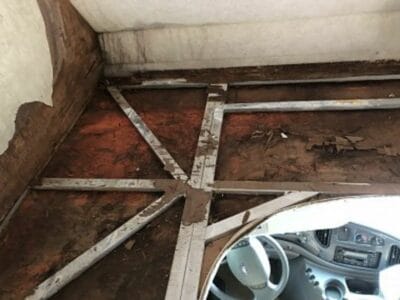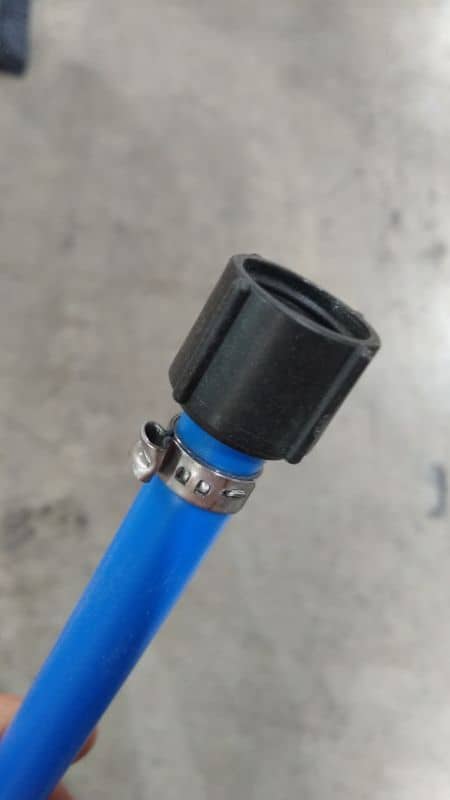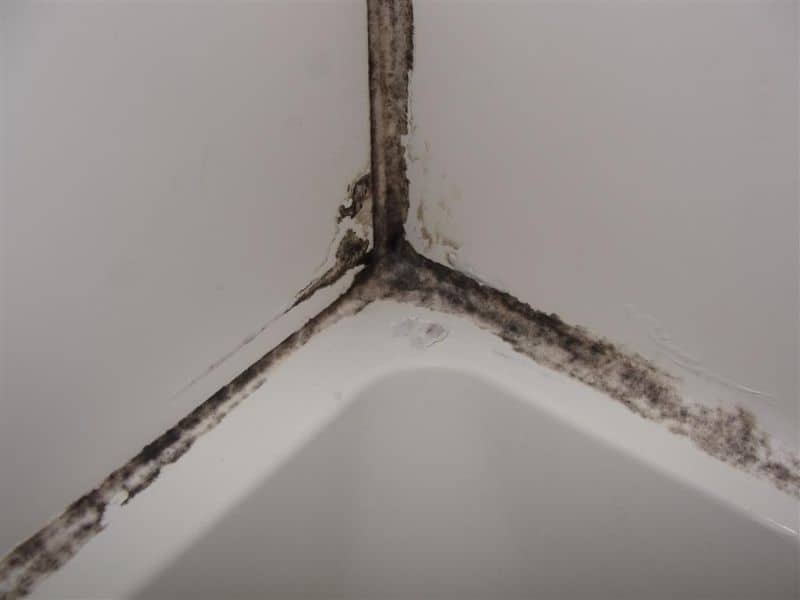Are you having nightmares of mold and mildew getting in your RV?
Mold and mildew aren’t the same things! Both are fungi. Mold tends to be the more health-hazardous of the two. It is darker and fuzzier. Mildew turns into a white, powdery substance.
Mold growth begins with a spore – or more than likely, a few bazillion of them. They’re everywhere. In fact, you’re probably inhaling a few right now. Thank your nose hairs for keeping your lungs clean!
Now, let’s find out what causes mold in an RV – and more importantly, how do you get rid of it?

How Does Mold Get in an RV?
A spore needs five ingredients in order to thrive:
- Food source.
- Warmth.
- Darkness.
- Oxygen.
- Moisture.
1. Food Source
Food can be wood, cardboard, paper, bread, tomatoes, even dust. Most any cellulose-based material can serve as food. In an RV, common mold sources include plywood paneling, paper wallpaper facing, and wooden sheet goods in furniture.
This is one reason why glass and plastic shed mold so easily. Mold can’t feed on glass; it can only feed on the dust and debris on the surface. If you keep the glass clean, the spores will starve.
2. Warmth
Mold can’t grow at sub-freezing temperatures. In fact, many molds thrive only between 70 and 120 degrees Fahrenheit. In general, mold is comfortable at the same temperatures you are. Many become dormant when the thermometer drops below 40 degrees – hence why your residential fridge is set at 39 degrees.
3. Darkness
UV light kills fungi spores and other microbes. Mold thrives in dark places like the interior of your cabinets and inside your ceiling structure. Unlike most plants, mold is not photosynthetic; it has no need of sunlight to grow.
4. Oxygen
They don’t need much, but a little oxygen is essential for growth. Mold won’t grow inside an airtight laminated wall, for instance. The challenge is that very few construction assemblies can truly be considered “airtight”!
5. Moisture or Humidity
Mold cannot grow in dry, arid conditions. Moisture, either liquid or vapor, drives growth. This is the number one problem when dealing with mold and mildew infestations in an RV or camper: Too much moisture!
Do All Campers Have Mold?
If you’re shopping for a used RV, it can seem like almost all older campers have mold or mildew: on the walls, the ceiling, the floor corners, etc.

This is for three reasons.
- RVs are built with a 15-20 year lifespan.
- Unlike houses, RVs are not built to “breathe.”
- RVs are normally stored unventilated.
You can’t do much about build quality. But you can choose to store your RV correctly so mold doesn’t have a chance to take hold!
P.S. It’s a common misconception – dare I say a fear – that all wood-framed campers will eventually mold. That is not, strictly speaking, true. There’s no reason a well-maintained wood-framed RV stored in a dry place will necessarily rot. I would pay more attention to the construction quality than anything else. Besides, if part of your structure does begin to rot from leaks, it’s usually your ceiling panels or your subfloor, first.
How to Prevent Mold in Your RV
Seal Your Roof
Most leaks in a camper originate from the roof. Common failure points are:
- The roof edge corner joints
- Pipe penetrations
- Roof fan and AC mounts
Wall penetrations are other usual suspects. Fridge vents are known to leak in high winds. Windows are the worst offender outside of roof-edge leaks.
I cannot overstate the importance of maintaining your roof sealants! Either check and/or re-seal your roof and wall caulking every 6-12 months, or else upgrade your RV roof with a permanent roll-on coating like RV Armor.
Check Your Plumbing

A network of semi-rigid PEX pipes, flexible vinyl hoses, and stiff white PVC pipes carry supply and drain water around your camper.
Common plumbing leak sources include:
- Loose PEX crimp rings
- The plastic threads on the backsides of outdoor showers
- Faulty water pumps
- Loose slip fittings underneath sinks
Most of these can be easily fixed with DIY tools and a half-hour of your time. Read my guide to fixing your own PEX here.
Store In a Dry Place
This is so important! There is no better way to prevent mold in your RV than by storing your RV in a dry place!
Preferably, that means an enclosed garage. If not that, then an RV carport. A camper should also be partially ventilated to reduce interior condensation from diurnal temperature swings.
Don’t use a tarp. Tarps just trap moisture and make the problem worse. You need to keep the interior humidity at 50% or less.
Use Anti-Mold Spray
Anti-mold spray contain fungicides and mildewicides that kill spores before they can proliferate. They are an excellent solution for mold-proofing cabinet interiors. They are not permanent, however. Most have to be seasonally reapplied.
However, not all are food-safe. A quick, effective DIY solution is undiluted white vinegar, which kills many mold species. (FYI, most soaps do not kill mold spores.)
How to Remove Mold from a Camper

If your RV already has mold, I have good news and bad news.
Good news: A thorough scrubbing with the above-mentioned sprays will eliminate the black mold and mildew from your shower, wallpaper, ceiling, etc. Cleaning with a bleach solution is the best way to kill any existing mold.
Bad news: If the mold has infiltrated your structure, there’s no easy fix. RVs aren’t designed for easy DIY renovation. Just removing an infected ceiling panel might require removing three cabinets, ceiling lights, and an air conditioner shroud!
This is one of those situations where an ounce of prevention is worth a pound of cure. By maintaining a low level of humidity, however, you can pause the mold growth. You won’t likely kill the spores, but you can make them dormant. That will reduce the musty smell and may alleviate asthma and allergic reactions, which is incredibly important to the air quality of your RV.
Leave a Reply